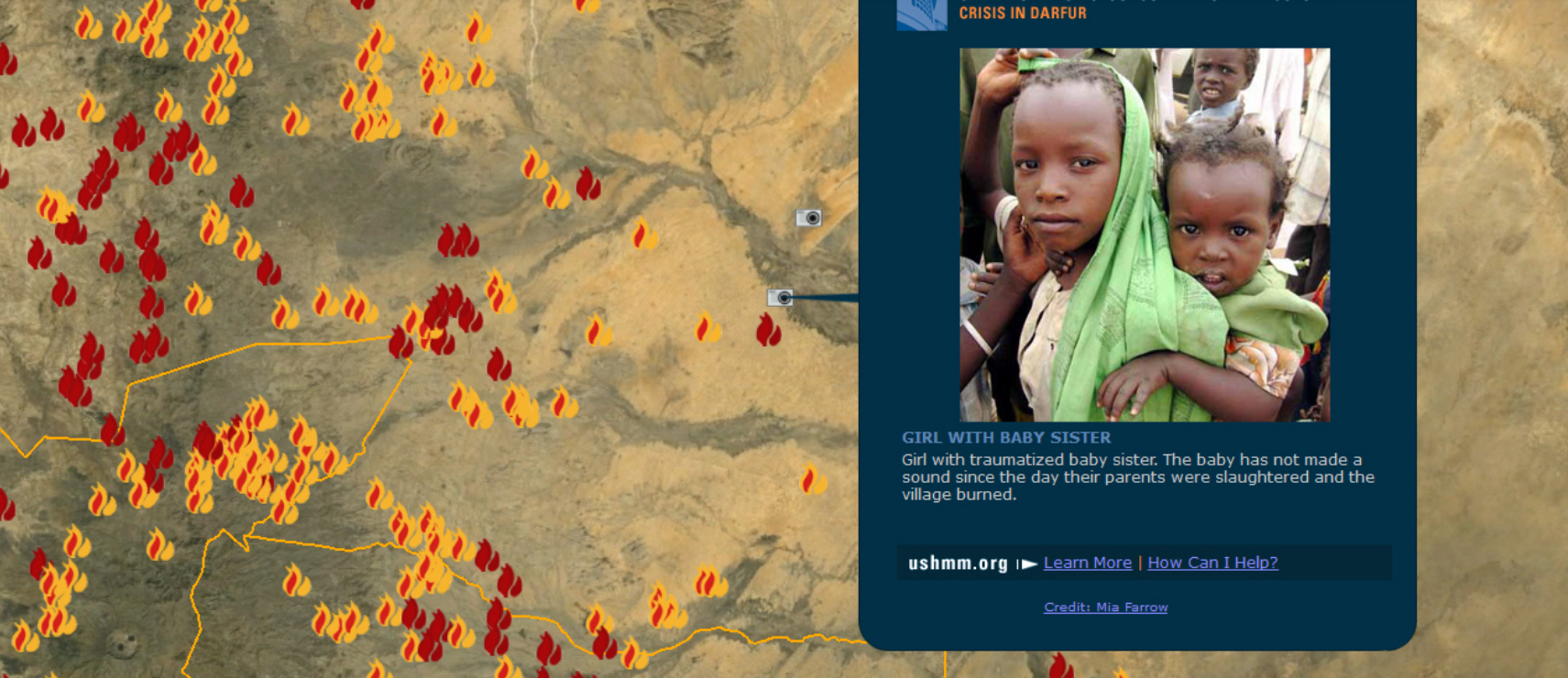Image source: https://www.google.com/earth/outreach/success-stories/united-states-holocaust-memorial-museum/
Click here to see PART 1 of this series.
Summary of Project
Crisis in Darfur is a collaborative project between the U.S. Holocaust Memorial Museum and Google to shed light on the genocide in Darfur, Sudan by combining satellite imagery and layers of data and multimedia on Google Earth. In the bigger picture, the purpose of this project is to bring mass atrocities across the globe to the surface and to transform the way information about such events is shared.
The Darfur crisis began in the Darfur region of Western Sudan in 2003- the first genocide of the 21st century- and continues to this day. The Janjaweed, a government-aided Arab paramilitary group, carried out the genocide by systematically destroying villages and homes, raping women and children, and torturing and murdering Darfurians, which resulted in the death of over 300,000 people. The destruction of 1,600 villages led to the displacement of 2.5 million people, who have had to seek refuge in neighboring villages and countries.
In spite of this, the Sudanese government claims that the “civil war” in Darfur has taken less than 9,000 lives in an attempt to hide the full extent and true nature of the crisis and to deny its role in it. Previously, claims like these were difficult to refute because of the limited access to evidence. Now, however, anyone with access to Google Earth can zoom into Darfur, Sudan, and see destruction of village after village in high-resolution.
How Crisis in Darfur was Accomplished
Crisis in Darfur began as a side project of several individuals in the Bright Earth Project, who saw the potential of Google Earth’s versatility to aid in disseminating information for human rights causes. Individuals saw that while the information was in existence, it was not viewer-friendly, as it was stored across different formats and locations on the web. Furthermore, it did not make sense for organizations to spend time and resources assembling and sharing individual maps each time they wanted to add to the ‘situational picture’ of a region. When they were able to combine the available technology with the existing data, however, this project grew into a collaborative one between Google and the Holocaust Memorial Museum.
Google Earth provided a medium for different forms of data and media to interact in a user-friendly way, as it could quickly create new maps from layers of data. Data was collected from various sources, such as the U.S. State Department, Amnesty International, and journalists and photographers collecting stories and images from the region, and layered onto the Darfur locality on Google Earth. As a result, this project allowed users to download layers for Google Earth that would allow them to view high-resolution satellite images of Darfur accompanied by photographs of destroyed villages and refugee camps, and testimonies of genocide survivors.
Impact of Crisis in Darfur
By combining Google’s satellite data imagery and the Museum’s data, this project was able to not only show the location of the attacks in Darfur, but to also show the impact on each village and its residents. The mass destruction is undeniable in the face of image after image of the charred remains of villages and of crowded tents in refugee camps that now house displaced Darfurians. The stories of Darfurians became more personal when people could see what had happened with their eyes through the photographic and video content provided by Museum staff and read their testimonies, as collected by Amnesty International.
Beyond the impact of this project in shedding light on the war in Darfur, the project has demonstrated the usefulness of Google Earth in mapping, documenting, and spreading awareness of human rights violations across the globe. Furthermore, it has encouraged the Holocaust Museum to branch out into creating a Genocide Preventing Mapping Initiative and Google to establish a Google Earth Outreach program, in which Google highlights layers of interactive data contributed by human rights organizations for increased user viewing and participation. It is clear that mapping can be a powerful interactive tool through which various actors, who often work individually to reach various audiences, can collaborate to share information with each other regarding shared issues and reach a wider audience.
Last Updated: January 2019
Author: Sarah Kim

